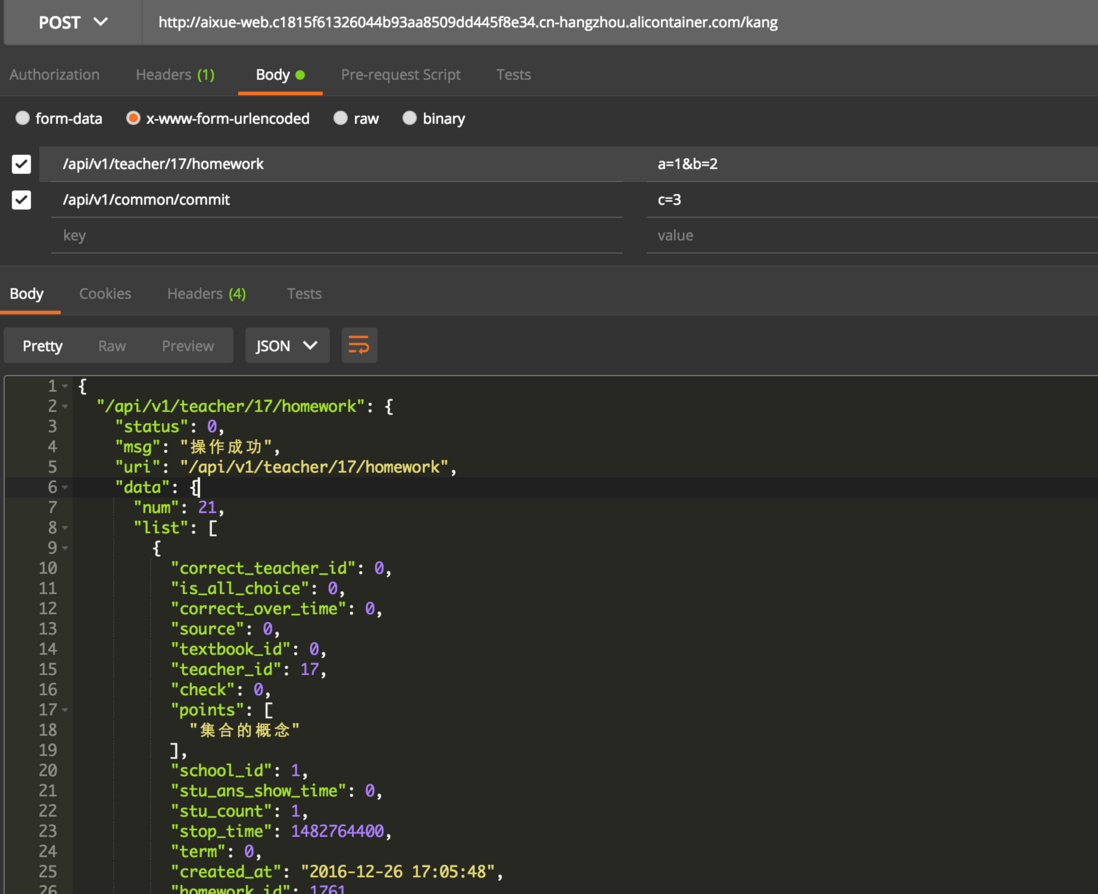配置openresty使用lua并发请求API
背景现在搞的系统前后端分离,采用 restful 风格设计 API. Lua语法lua特殊点 一.数据类型 nil 空 boolean 布尔 number 数字 string 字符串 table 表 local corp = {
name = “kang”,age = 20
}
function 函数 local function foo()
local x=10;
local y=20;
return x+y;
end;
local a=foo;
a();
二.表达式 算术运算符 关系运算符 逻辑运算符 字符连接 也可以用 string 库的函数 string.format 连接字符串. string.format(“%s-%s”,”hello”,”word”); hello-word 推荐使用 table.concat()来进行字符串拼接.因为 lua 中字符串是只读的.连接操作会创建一个新的字符串.性能损耗大. 三.表达式 1.单个 if 分支 x=10
if x>0 then
print(x);
end;
2.两个分支 if-else x=10
if x>0 then
print(0);
else
print(1)
end;
3.多个分支 if-elseif-else score=10
if score==10 then
print(1)
elseif score==11 then
print(2)
else
print(3)
end;
4.whie 控制结构 todo end; x=1
sum=0
while x<=5 do
sum = sum+x;
x = x+1;
end;
5.repeat 控制结构 repeat
todo
until 条件==假
6.for todo end; for i=1,5,1 do
print(i);
end;
泛型 local a= {“a”,”b”,”c”}
for i,v in ipairs(a) do
print(i,v)
end;
lua 的基础库提供了 ipairs. 这是一个用于遍历数组的迭代器函数. 函数 函数的定义 function name (arc)
todo
end;
name = function (arc)
end;
没有 local 修饰的都是全局变量.因此函数声明局部函数也要用上 local local function name (arc)
todo
end;
函数名还可以是 table 数量类型中某个字段. function stu.getName()
todo
end;
函数的参数 在调用函数的时候,若形参个数和实参个数不同时,Lua 会自动调整实参个数。调整规则:若实参个数大于形参个数,从左向右,多余的实参被忽略;若实参个数小于形参个数,从左向右,没有被实参初始化的形参会被初始化为 nil。 变长参数 local function func( ... )
local tmp = {…}
for k,v in pairs(tmp) do
print(v)
end;
end;
函数的返回值 loca s,e = string.find(“hello word”,”llo"); 返回多个值时.值之间用”,”隔开. 调整规则: 若返回值个数大于接收变量的个数,多余的返回值会被忽略掉; 若返回值个数小于参数个数,从左向右,没有被返回值初始化的变量会被初始化为 nil。 注意:当一个函数有一个以上返回值,且函数调用不是一个列表表达式的最后一个元素,那么函数调用只会产生一个返回值,也就是第一个返回值。 local function init() -- init 函数 返回两个值 1 和 "lua"
return 1,"lua"
end
local x,y,z = init(),2 -- init 函数的位置不在最后,此时只返回 1
print(x,z) -->output 1 2 nil
local a,b,c = 2,init() -- init 函数的位置在最后,此时返回 1 和 "lua"
print(a,c) -->output 2 1 lua
模块 定义个模块 my.lua local foo={}
local function getname()
return "Lucy"
end
function foo.greeting()
print("hello " .. getname())
end
return foo
定义个 main.lua.调用 my.lua模块 local fp = require("my")
fp.greeting() -->output: hello Lucy
元表 setmetatable(table,metatable) local mytable = {}
local metatable = {}
setmetatable(mytable,metatable);
or
mytable = setmetatable({},{})
修改表的操作符行为 local table_1 = {10,20,30};
local table_2 = {40,50,60};
local metatable = {};
metatable.__add = function (self,another)
local sum = {};
for k,v in pairs(self) do
table.insert(sum,v);
end;
for k,v in pairs(another) do
table.insert(sum,v);
end
return sum;
end;
setmetatable(table_1,metatable);
table_3 = table_1+table_2;
for k,v in pairs(table_3) do
print(v)
end
除了加法可以被重载之外,Lua 提供的所有操作符都可以被重载: 元方法 含义 元方法 含义 组合设计安装 openresty 推荐使用官网教程 配置 nginx 使用 lua location /kang {
add_header content-type application/json;
content_by_lua_file lua/kang.lua;
}
lua代码 --加载 json 库
local json = require "cjson";
--获取请求方式
local request_method = ngx.var.request_method;
--判断请求方式
if request_method == "GET" then
ngx.say(json.encode({"only post"}));
return;
end;
--读取 post 参数.表单需要是 x-www-form-urlencoded
ngx.req.read_body();
local api_p = ngx.req.get_post_args();
--拼接子请求
local list = {};
for api,p in pairs(api_p) do
local tmp = {api,{args=p,method=ngx.HTTP_GET}};
table.insert(list,tmp);
end;
--发送子请求
local response = {ngx.location.capture_multi(list)};
--合并响应
local data = {};
for num,resp in pairs(response) do
resp = json.decode(resp["body"]);
data[resp["uri"]] = resp;
end;
--响应到客户端
ngx.say(json.encode(data));
坑 配置 location location /api {
#记录下子请求的请求方式,uri
set $my_uri $uri;
set $my_method $echo_request_method;
root /var/www/html;
index index.html index.htm;
try_files $uri $uri/ /index.php?$query_string;
access_log /usr/local/openresty/nginx/logs/access.log main;
}
location ~ .php {
root /var/www/html/laravel/public;
include fastcgi_params;
#fastcgi_pass unix:/home/wenba/php/var/run/php.sock;
fastcgi_pass 127.0.0.1:9000;
fastcgi_split_path_info ^((?U).+.php)(/?.+)$;
fastcgi_index index.php;
fastcgi_param REQUEST_URI $my_uri;
fastcgi_param REQUEST_METHOD $my_method;
fastcgi_param SCRIPT_NAME $fastcgi_script_name;
fastcgi_param SCRIPT_FILENAME $document_root$fastcgi_script_name;
}
请求
(编辑:李大同) 【声明】本站内容均来自网络,其相关言论仅代表作者个人观点,不代表本站立场。若无意侵犯到您的权利,请及时与联系站长删除相关内容! |

